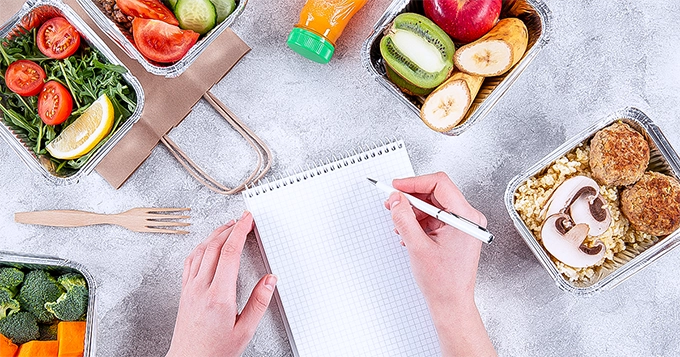A food journal can help you understand your daily eating habits, how they affect your way of living, and how to track diet. The majority of experts concur that accuracy and reliability are key components of a good food journal.
If you’re new to the idea of food journaling, here are the answers to some of your food tracking questions.
The Benefits of Tracking Your Food
You can establish a sustainable diet plan by tracking your food.
It’s easy to forget what you eat when you don’t routinely keep track of your meals. With a food-tracking tool, you can correctly and consistently record your food consumption. So, for example, if you are trying to lose weight and are on a 1,500-calorie diet, you can easily monitor and stick to your target calories and macros.
You can track your food’s nutrient value.
If you are simply tracking what food you eat without its nutritional value, tracking your food will be pointless. Carbs, fats, and protein are the three macronutrients your body requires to function correctly. You may eat enough calories daily but could have eaten more fats and less protein than necessary.
With the help of meal trackers, you can keep track of everything you eat and see precisely how many macronutrients you need to consume. Thus, you’ll be more inclined to eat a varied diet rich in fresh vegetables, healthy fats, complex carbohydrates, and protein to acquire the macronutrients your body needs.
It helps with mindfulness and accountability.
It’s easy to lose track of all the food you’ve eaten recently, even the ones you just ate a few hours ago. However, every food item, from a bowl of salad to an orange juice, needs to be recorded. When you regularly journal your meals, it holds you accountable and makes you much more deliberate about what and when you eat. Because you have to document it, it also encourages you to remain mindful of your diet.
It helps you achieve your nutrition and fitness goals.
Once you are aware of the calorie and nutrient content of your food choices, you can’t help but use that knowledge in the future to support you in reaching your goals.
For example, instead of ordering just anything on the menu, you look up the calorie content of a food item before making a choice. You might discover that one food might cause you to consume far more calories than you had planned, so you might decide to go with something different that fits your calorie limit for the day.
It allows you to eat your favorites in moderation.
Eating some of your favorite not-so-healthy foods is still fine if you do it in moderation and as long as you remember to log them. It makes it easier for you to recognize if you’ve eaten enough already or when you’ve gotten off track.
It gives you more insight into your current eating habits and food sensitivities.
Food journaling involves writing down the time and how you’re feeling before, during, and after you ate the food. For example, you might notice that you eat more sweets when you’re feeling down or notice an allergic reaction after eating certain foods.
How to Keep a Food Journal?
First things first.
If you’re trying to shave off some pounds and you’re wondering how to track macros to lose weight, the traditional way is to grab a notebook and pen. Then, you list all the foods you ate, what time you ate them, their caloric values, and their macronutrient content: total carbs, total fats, and protein.
But the modern, easiest, and most accurate way to track your food intake is through using food tracking apps such as Trainest.
On this app, you can access a comprehensive database featuring over a million food items. Scan barcodes, save beloved meals and recipes hassle-free, all for free on Android and iOS. Simply use your phone to update your food journal anytime, anywhere, ditching the need for a notebook and pen.
What to Track?
Here are 7 things a basic food diary should include:
- Food
You should record the precise meals you consume each day. Include information on the preparation method, such as if it is baked, grilled, or fried. Include any condiments, dressings, oils, sauces, and toppers. Beverages should also be tracked; coffee, tea, and smoothies all count.
- Portion size
Include the exact serving sizes of the stuff you consume. Include specifics like a cup of ice cream, two tablespoons of butter, or 20 pieces of half-almonds. It is crucial to measure your meals and keep track of how much you really consume, depending on your goal.
- Time
Take note of when you eat. By doing this, you can discover your eating habits. Skipping meals or eating late might cause overeating later. In order to improve your eating habits and health, time tracking can assist in developing more balanced eating practices.
- Place
Tracking where you eat is another aspect that aids in identifying your tendencies. Are you consuming food while hurrying, watching television, or both? Are you multitasking when standing at the counter or seated at the dinner table? Knowing where you eat can help you make conscious decisions that improve the caliber of your food selections.
- Hunger levels
Many people eat when they are not physically hungry and consume more food than they need. It is beneficial to track hunger levels in a food journal. With this mindful technique, You can decide when to stop eating (stopping when you are satisfied already) and to eat at times when you are physically hungry.
- Feelings
For those who want to lose some pounds, success in improving your nutrition or reaching your goals through food journaling isn’t just all about knowing how to count macros for weight loss. It’s also about your feelings and your relationship with food.
It might be useful to track your feelings before and after eating by writing them down. You’ll discover what sets off unhealthful eating habits, such as nighttime emotional eating or stress-related vending machine raiding at work.
- Total calories and macronutrients
Aside from noting what and how much food you eat, including the total calories and the macronutrients, ensure that you are not just hitting your target calorie count but also getting the proper amount of nutrients for your body.
If you want to know how to count macros for weight loss, this little guide might help you:
Carbs. 1g of carbs = 4 calories.
Fats. 1g of fats = 9 calories.
Protein. 1g of protein = 4 calories.
You can allot how many grams per macronutrient you should take in a day to ensure you won’t exceed your total calorie daily limit while ensuring you get enough nutrients that your body requires to function.
How to track diet and food intake properly relies heavily on honesty. Authentic journaling not only enhances the effectiveness of your tracking but also cultivates healthier habits, contributing significantly to your overall health and well-being.
Ready to experience optimized nutrition tracking? With 1,000,000+ verified foods in our database and convenient smart features, your experience will be seamless with Trainest.
And the best part? You can access all the tools, features, and benefits completely free! Download Trainest now on IOS & Android.








